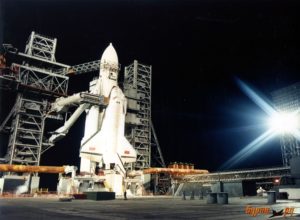
In part one of a three-part feature, Vitaly Egorov describes Russia’s modern posture in space and the challenges and possible ways of development of the national space industry. This first part explains how the country that used to be first so many times when it comes to space exploration has reached its current state.
The High Orbit
In order to gain an understanding of today’s state of the Russian space industry, one should first delve into the history of Soviet space exploration. The space programme of the USSR was originally conceived for military purposes. The need to develop a capability to deliver a nuclear warhead to a target on another continent stimulated an active development of the industry. Nearly every Soviet launch vehicle was developed as a military contract: the R7 Vostok, Soyuz, and UR500 (Proton) launch vehicles were initially designed as nuclear and thermonuclear warhead carriers. The Zenit and the Energiya rockets were conceived as military satellite launch vehicles, to be used in the confrontation with the United States’ Strategic Defense Initiative (SDI), also known as ‘Star Wars’.
On the other hand, the launch of the first Sputnik satellite and the flight of the first cosmonaut Yuri Gagarin defined the space programme as a powerful propaganda tool. The Soviet record achievements in outer space were meant to demonstrate the supremacy of the Communist regime, support the Soviet Union’s existing political allies and helped to attract new ones to the camp. A self-declared pioneer of humankind in pushing space boundaries, the Soviet Union was indeed the driving force behind the national space programmes of the friendly and allied nations of Eastern Europe and Asia, participating in joint satellite missions and even launching foreign cosmonauts to low-Earth orbit. Robotic landings on the Moon, Mars, and Venus also helped to demonstrate the supremacy of Soviet science and engineering, the Soviet lifestyle, and confirmed the declarations of peaceful space exploration.
Both these functions of the Soviet space industry were part of the military and ideological stand-off in the Cold War with the United States. Civilian application of the space industry was a low-priority task.
The 1980’s saw the peak of the Soviet space programme. The Buran-Energiya and the Mir space station projects played a key role in modernizing the industry, developing industrial, testing and launch infrastructure, similar to what the Apollo project had done for the United States. By some estimates, there were years when the Buran-Energiya project consumed up to 6% of the USSR’s annual fiscal budget. What was achieved was comparable with the U.S. Apollo programme: a super-heavy launch vehicle was created, cutting-edge rocket engines were developed, which had well-nigh reached energy efficiency limits, and a reusable aerospace vehicle was created.
To Survive By All Means
When the Soviet Union collapsed in the early 1990s, all hopes of further development of its space industry were shattered overnight. From the highly ambitious mission to Mars and the Vulkan rocket with the 200-ton lifting capacity, Russian space engineers had to look for means of survival. The main challenge for the Russian space industry at that time was the national economic crisis, which caused industry funding to plummet.
A less noticeable change, but one that is still felt today, was that of military space applications and propaganda no longer being part of the space programme. With the Cold War now over, there was no more threat of a nuclear confrontation, which rendered early warning satellites obsolete, as well as the global positioning system for aiming ballistic missiles. The nascent Russian State was now busy copycatting the capitalist system of its former ideological opponent, and the crewed and automatic space programmes were not much help in this. The interplanetary research programme was almost completely mothballed, except for the failed Mars-96 mission. As for the crewed space programme, it was mostly kept alive due to the funding provided by the United States and European nations.
Under these harsh economic conditions the Russian space industry was hastily trying to find new goals for itself. Struggling for survival became the key priority, which later morphed into the ‘maintaining access to outer space’ kind of motto. The role of space exploration as a propaganda tool was still there to a certain extent, but, having lost its international grip, it was now mostly aimed at domestic audiences. The Ministry of Defence is still a major customer with orders for satellite launches, although on a much smaller scale than in previous times.
The Russian space industry was forced to enter the global commercial launch market, in an effort to find new sources of income. In the early 1990’s, the industry had no choice but to auction a lot of its hardware assets, from historic space suits to lunar soil samples to the Lunokhod-2 rover. Even rocket launcher technology was being sold to other nations. The latter fact caused indignation in the United States, fearing certain nuclear countries might develop their own ballistic missiles. The 1992 treaty between Russia and India on the transfer to the latter of hydrogen rocket engine technology was therefore suspended. As compensation, Russia received funds from the U.S. during the 1990s to operate the Mir space station. Joint Russian-American ventures were created with the goal of commercializing Russian rocket technology in the U.S. and global markets, as well as the joint Mir-Shuttle programme and contracts for purchasing Russian rocket engines.
The space technology most heavily invested in by the Soviet Union helped to find a right niche in the global market with regular demand for Russian space technology. Russian-converted and mass-produced rocket launchers turned out to be at least 1.5 times cheaper than their American and European counterparts. Seats on Russian piloted missions for NASA and ESA astronauts, as well as for private paying customers, became another significant source of income for the Russian space programme. NASA and the Chinese space programme were actively learning from the Soviet-Russian experience in designing manned space vehicles and long-term space stations. The engine technology developed as part of the Buran-Energiya project were in demand as well.
The Russian space industry became something of an international ‘space taxi driver’ as well as a technical consultant, ensuring the development of commercial and manned space programmes in different nations. However, the acquired funds were insufficient to fully cover the industry’s needs. In the early 2000’s international contracts provided up to 25% of Roscosmos’s income, the rest being provided by government contracts. The total funds were insufficient to support modern technology development but made step-by-step modernization possible, which was often paid for by international clients.
Currently, Russia’s space programme still tries to preserve its earlier potential while providing employment for citizens. Even new projects such as the Angara and the Soyuz-5 rockets borrow heavily from the earlier Zenit and Energiya projects.
One cannot but praise the success of the Russian space industry’s effort to preserve its Soviet foundations. With funding that is only one-tenth of NASA’s and one-third of the Chinese space agency, Roscosmos possesses the capabilities and resources that facilitate a wide variety of tasks:
- The full manufacturing cycle of rocket launchers, ranging from light to heavy-duty models, which enable access to all types of utilized orbits;
- Liquid-fuel rocket engines using high- and low-boiling-point propellants, including closed-cycle rockets;
- Cargo resupply and manned space vehicles;
- Manufacturing of space station modules and life support systems;
- Space suits, both rescue and EVA types;
- Docking units and automated docking technology;
- Experience in manned space missions and enormous amounts of collected data on space medicine and biology;
- Manufacturing of remote sensing satellites with the capacity of submeter resolutions and weather satellites;
- A fully functioning global navigation system;
- Manufacturing of a wide range of geostationary telecommunication satellite platforms;
- Upper rocket stages with multiple burn capacity, which provide pinpoint orbit positioning of satellites as well as interplanetary trajectory insertion;
- Operating several cosmodromes, which enable launches of all manufactured space launchers;
- Testing facilities for rocket engines including the most powerful ones and of all types of manufactured spacecraft;
- Manufacturing of electric rocket engines;
- Development of nuclear rocket engines;
- Manufacturing of scientific instruments for interplanetary and astrophysical research.
It can be said with absolute certainty that there is no space agency out there with such a wide variety of capabilities and technologies, which is a justified source of pride for Roscosmos. Russia’s space exploration potential is behind only that of the United States in terms of solid rocket fuel engines and deep space robotic missions. Russia’s interplanetary mission efforts have been beaten by Japan, India, China and the United States, which clearly demonstrates the loss of the propaganda role of scientific achievements in space as well as a lack of other types of motivation for developing this branch of space industry for the nation’s leaders.
At the same time, the variety of capabilities and Roscosmos’s well-developed infrastructure led to a dilution of the budget allocated to the space industry, which is insufficient to finance it to full capacity. State contracts have to be spread evenly between some seventy manufacturers and research institutions employing a total of approximately 200 000 specialists. The money just is not enough to develop all necessary technology, which leads to a loss of competitive edge relative to more dynamic market players that are focused on developing more specific competencies. The U.S.-built Falcon 9 rocket has surpassed in popularity the Proton, the former commercial launch leader. Russian navigation and telecommunication satellites suffer from low reliability and have an operational life that is twice as short as their European or American counterparts. Russian remote sensing satellites are 5-10 times the mass of their rivals and lag behind in terms of data quality. Two attempts at launching an interplanetary robotic mission in 1996 and 2011 ended up in the depths of the Pacific.
The former economic advantage of Roscosmos – its comparatively lower remuneration rates – is losing to higher labour productivity in commercial U.S. space companies as well as to the Indian space industry aggressively entering the international launch market.
The last bastion which Roscosmos might still monopolize is piloted space missions. But rivals are breathing down the Roscosmos neck here as well: three manned spacecraft are being developed in the U.S., while China has its own manned and cargo ships. The Chinese are getting ready with the launch of their own multi-modular space station and show a willingness to offer it as a platform for joint projects with other nations.
In part two of this three-part feature on Russia’s modern posture in space, Vitaly Egorov will look at how space exploration is often associated with extremely ambitious goals. Which one will Russia choose for the next few decades? What will be more beneficial in terms of public support and international cooperation? Part II will be published on Friday, 23 March 2018.

Vitaly Egorov is a PR specialist for the Russian private company Dauria Aerospace. He has a blog under the nickname Zelenyikot, manages the group called Open Space on Facebook and vk.com with the total number of followers exceeding one million, and promotes space exploration in every possible way. He spotted the landing module of the Soviet probe Mars 3 on the Martian surface for the first time and initiated the microsatellite project for taking pictures of the Apollo and Lunokhod landing areas on the Moon.
 SpaceWatch.Global An independent perspective on space
SpaceWatch.Global An independent perspective on space




